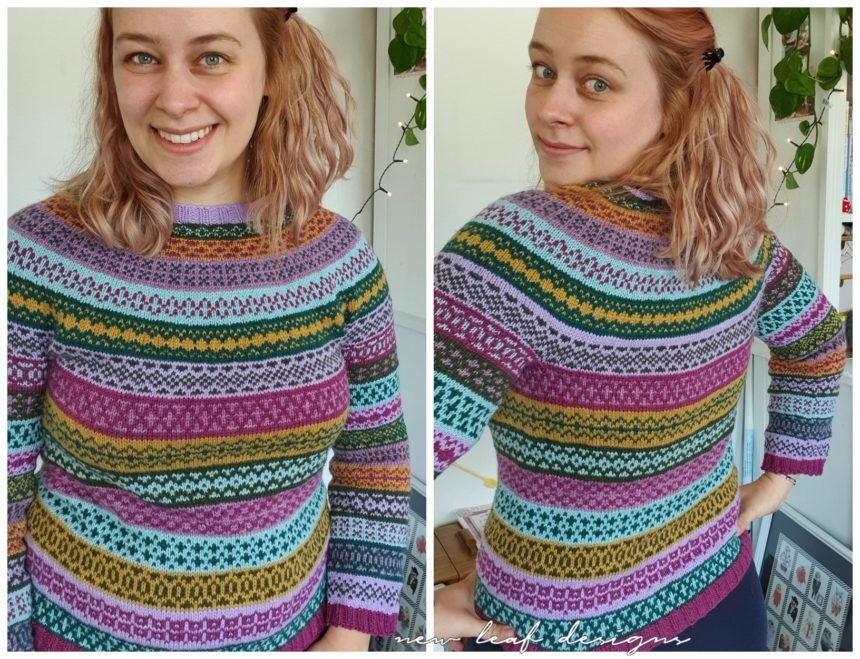
Around the World Sweater Pattern
My newest knitting pattern is finally here: the Around the World Sweater! Probably my most labour intensive pattern so far, and I’m so curious to see if you guys like it. I hope you do! This sweater is designed with Scheepjes Metropolis yarns, a soft but sturdy yarn that can be used for socks as well as sweaters, and many other things! Because the colourways are named after cities around the world, I decided to name this sweater the ‘Around the World’ Sweater. It’s a perfect sweater pattern if you’ve never knit a sweater before. I do recommend experience with colourwork knitting.
This blogpost will probably be very long, so I’ll explain how it is divided: first you will find the English written pattern. After that, the Dutch written pattern. Be sure to turn your automatic translator off so you don’t get confused. At the bottom of this blogpost, I will put the colourwork charts since these are the same for both languages. There is also a PDF version (paid) of this pattern, if you would like all information in a nice and printable format, including EVEN MORE colourwork charts! Find the PDF version on Ravelry, and in my own webshop.
Mijn nieuwste breipatroon is er: de “Around the World” trui! Er zitten héél wat uurtjes werk in dit patroon, en ik ben zo benieuwd wat jullie er allemaal van vinden. Ik hoop dat jullie het net zo leuk vinden als ik! Deze trui is ontworpen met Scheepjes Metropolis garens, een zacht maar robuust garen dat je voor zowel sokken als truien kunt gebruiken, en nog voor veel meer moois. Omdat de kleuren allemaal vernoemd zijn naar steden over de hele wereld, heet deze trui de ‘Around the World’ trui. Dit patroon is perfect als je nog nooit een trui hebt gebreid, ik neem je door alle stappen mee. Ik raad wél aan om ervaring te hebben met kleurwerk breien (inbreipatroontjes).
Deze blogpost wordt waarschijnlijk erg lang, dus ik leg even uit hoe je je weg kunt vinden. Hier bovenaan volgt eerst het Engelse geschreven patroon. Daaronder volgt het Nederlandse patroon, eventjes naar beneden scrollen en dan vind je het. Helemaal onderaan staan de kleurwerk schema’s. Er is ook een PDF versie (betaald) van dit patroon, wat handig is als je alle informatie in één plek wilt hebben, of als je hem wilt printen. Het PDF bevat ook nóg meer kleurwerk schema’s! Vind de PDF op Ravelry, en in mijn eigen webshop.
Tutorial videos can be found on my Patreon page, where we will have a knit-a-long for this sweater! Have you never knitted a sweater before? No worries, in my videos I will show you how to cast on, increase, knit colourwork, knit shortrows, split for the sleeves, and so on. The videos are available from the Jonagold, Golden Delicious, and Elstar patrons will also receive the PDF pattern as a free download.
Ik heb ook tutorial filmpjes, deze vind je op mijn Patreon pagina, waar we een knit-a-long houden! Als je nog nooit een trui hebt gebreid raad ik dit sterk aan. In mijn filmpjes laat ik je zien hoe je opzet, meerdert, kleurwerk breit, verkorte toeren breit, de steken voor de mouwen opzij zet, en nog veel meer. Let wel op: de filmpjes zijn alleen in het Engels. Vanaf het Jonagold level krijg je toegang tot de filmpjes, en de Golden Delicious en Elstar patrons krijgen ook het PDF patroon als een gratis download.
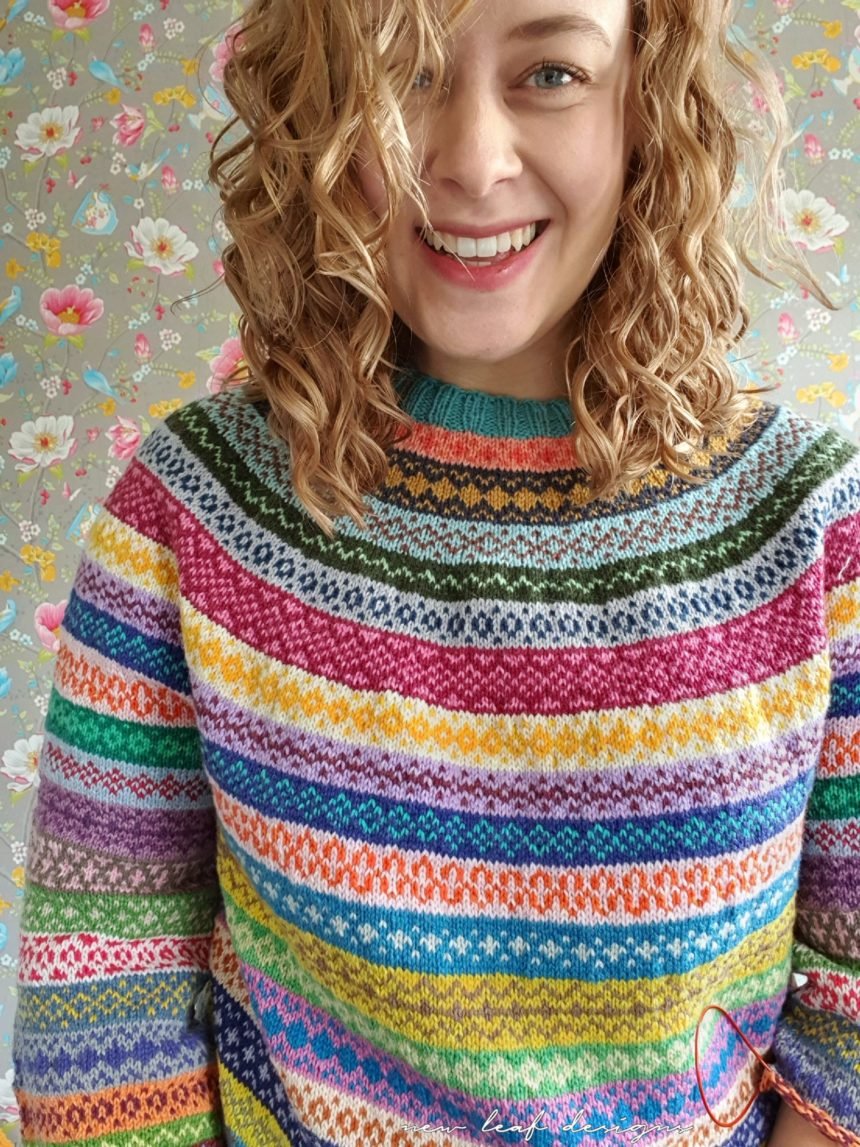
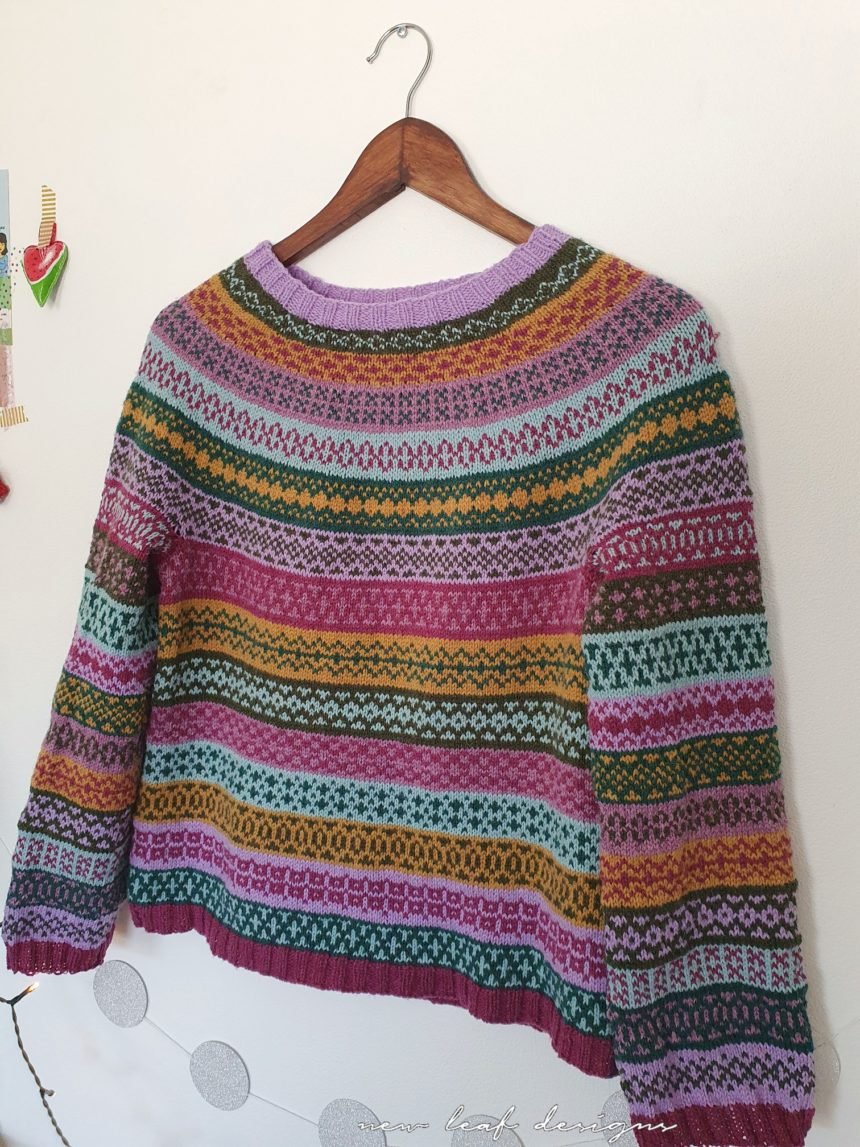
Yarn/Where to Buy
Scheepjes Metropolis (75% Merino extra fine, 25% nylon; 200m/50g)
For sizes 32;34;36;38(40;42;44;46)48;50;52;54 (56;58;60;62) you need: 8;8;9;9(10;10;11;11)11;12;13;13(13;14;14;14) balls*
meterage: 1485;1585;1690;1790(1895;1945;2045;2150) 2200;2300;2405;2455(2560;2660;2710;2760)
yardage: 1624;1733;1848;1958(2072;2127;2236;2351) 2406;2515;2630;2685(2800;2909;2964;3018)
*Please note that the amount of balls needed depends on how many colours you choose. For example: if your size sweater needs 10 balls, and you choose 8 colours to knit it, you will probably need 2 balls of each colour, als you will use 10/8= 1.25 balls of each colour.
Colours used for sample:
016 Karachi (dark forest green)
026 Depok (dark army green)
050 Bogotá (wine red)
035 Seoul (mustard yellow)
055 Lima (bright purple)
054 Johannesburg (soft medium purple)
019 Marseille (mint green)
Get your Scheepjes Metropolis yarns via your local retailer, or perhaps consider to shop via one of the affiliate links below:
Wool Warehouse (UK) Caro’s Atelier (NL)
Other Materials
80cm long circular knitting needles in the following sizes:
3mm for the main body – or other size to obtain gauge
2.25mm for the ribbing
Scissors
Darning needle
4 stitch markers; one of these should look different from the other three to be easily recognizeable as the ‘beginning of the round’ (BOR) marker
Gauge
Blocked gauge:
27 sts x 32 rounds of colourwork stockinette with 3mm needles measures 10x10cm.
Notes on gauge: if necessary, use different needle size to reach gauge. Please note the gauge is measured on a swatch knit in the round.
Abbreviations
BO : bind off
BOR : beginning of round
CC : contrast colour; in this pattern meaning the contrast colour in a colourwork stripe
CO : cast on
k : knit
k2tog : knit 2 sts together through front loops
m : marker
M1 : make one (increase): pick up horizontal bar between current and next st, put on lefthand needle, knit through left leg so there’s no big gap.
MC : main colour; in this pattern also “background” colour of a colourwork stripe
p : purl
pm : place marker
sl : slip purlwise
sm : slip marker
st(s) : stitch(es)
RS : right side
WS : wrong side
(…) : repeat the instructions between brackets as many times as indicated
[…] : stitch count
Special Stitches:
DS – Double stitch : same as German Shortrow stitch. After turning the work, with yarn forward, insert needle into next st as if to purl and slip it off the lefthand needle. Pull yarn tight and take it OVER the top of your work to the back. Instead of the one st on your righthand needle you should now see two small loops. These two loops count together as one st. Continue knitting, making sure to take the yarn forward again in between the needles if your next st is a purl st.
Sizing
Please find the references A-E of the schematic in the Sizing Table below.
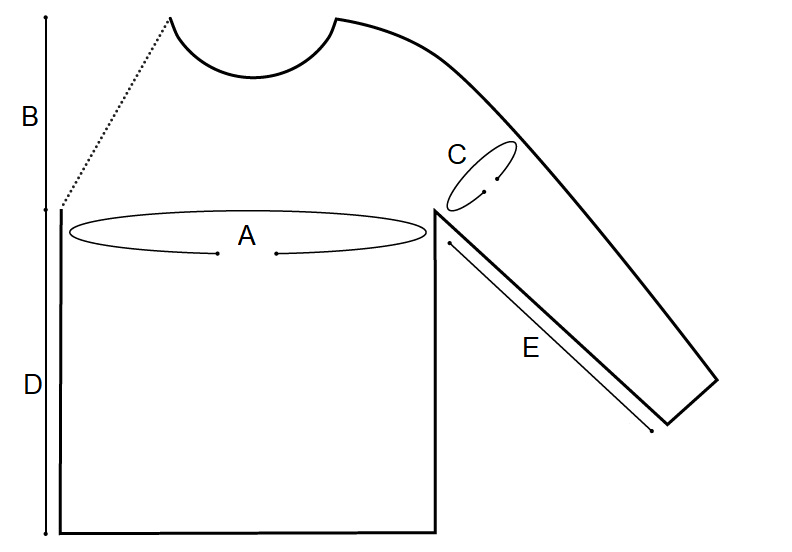
Please note: this sweater is designed to be worn with 5-10cm / 2-4″ of positive ease. All sweater measurements are given in their blocked state.
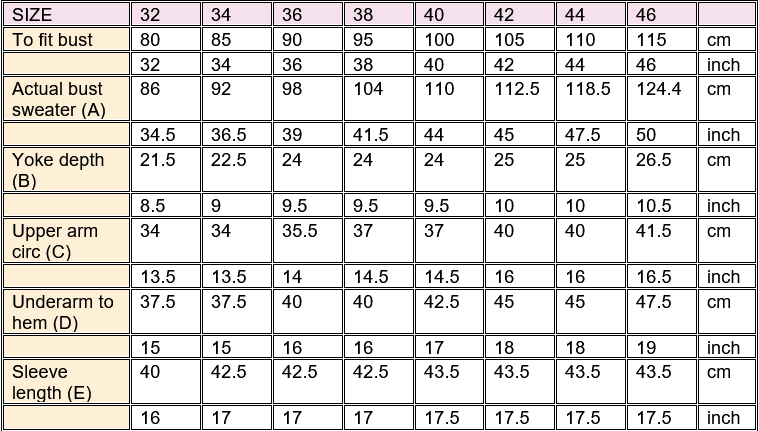
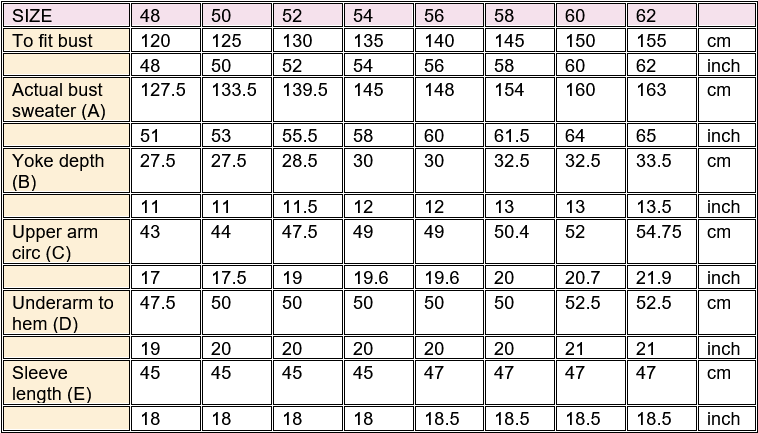
Pattern Notes
This pattern is for a top-down sweater knit in the round. You will start at the neck ribbing and knit down from there, making shortrows for the back in order for the back of the neck to be a little higher. Increases are made evenly throughout the yoke. Two sections are set apart on stitch holders for the sleeves, and the body is knit in the round all the way to the hem. Then, the sleeves are knit directly from the stitches on stitch holders and knit in the round to the sleeve cuff.
In the pattern I will refer to the two needle sizes as ‘smaller needles’ and ‘bigger needles’. It depends on your gauge whether you use the recommended needle size (see Materials).
Colour Notes
For the colourwork sections, you will be using two colours of yarn in each stitch pattern. These two yarns need to contrast enough so you can see the pattern. One way of finding yarns with enough contrast is taking a picture of your yarns and converting it to greyscale. If the yarns are still visibly different, you can use them together in the same colourwork pattern.
For the colours used in the purple-green sample, there are 3 darker shades (Karachi, Depok, Bogotá) and 4 lighter shades (Marseille, Seoul, Johannesburg, Lima). The darker shades can be used with the lighter shades, but don’t use 2 darker shades together or 2 lighter shades.
For the rainbow coloured sample I used a Scheepjes Metropolis colour pack with 10g minis of all 80 colours.
Colourwork charts
Please find the colourwork charts at the bottom of this blogpost, categorized by number of rounds. Please remember to knit at least 1 MC round before and after each chart. The charts are to be read bottom to top, right to left. Each chart shows two repeats, the main repeat is shown in a red outline. The squares each signify 1 stitch: the white squares are MC stitches, the black (main repeat) and grey (outside of main repeat) squares are CC stitches.
Each colourwork pattern is a repeat of 4 stitches.
Pattern
Instructions and stitch counts for different sizes are given as follows: 32;34;36;38(40;42;44;46)48;50;52;54(56;58;60;62)
Alternatively, instructions can be given for different sizes as follows (example):
For sizes 34;40;44;52: “…”
Size 42: “…”
In this case, search for your size, then follow the instructions given.
Casting on
With smaller needles and your colour of choice for the neck ribbing, CO 96;100;108;112 (120;124;128;136) 140;144;148;152 (156;160;164;168) sts, pm at every 24;25;27;28 (30;31;32;34) 35;36;37;38 (39;40;41;42) sts.
Join in the round, taking care not to twist the stitches and place BOR marker at join. The BOR marker will be at the back of the right shoulder.
In total you should now have 4 markers. These stitch markers will divide your sts in 4 equal parts and will be used for shortrow shaping. When they are not mentioned, please just slip the markers as you go.
Knit in 2×2 rib – (k2, p2) – for about 2.5cm/1”.
Switch to larger needles for next round and join first MC. You can cut the colour you used for the ribbing.
Increase Round 1
NOTE: sometimes you will need to make an increase right at a stitch marker. In those cases, m1 before the marker, not after.
For sizes 32;38;44;50;58: (K4, m1) until end. [120;140;160;180;200 sts]
Size 34: K2, (m1, k3) 6 times, (m1, k4) 15 times, (m1, k3) 6 times, m1, k2. [128 sts]
Size 36: k2, (m1, k3) 2 times, (m1, k4) 23 times, (m1, k3) 2 times, m1, k2. [136 sts]
Size 40: k2, (m1, k3) 4 times, (m1, k4) 23 times, (m1, k3) 4 times, m1, k2. [152 sts]
Size 42: k2, (m1, k3) 2 times, (m1, k4) 27 times, (m1, k3) 2 times, m1, k2. [156 sts]
Size 46: k2, (m1, k3) 4 times, (m1, k4) 27 times, (m1, k3) 4 times, m1, k2. [172 sts]
Size 48: k2, (m1, k3) 2 times, (m1, k4) 31 times, (m1, k3) 2 times, m1, k2. [176 sts]
Size 52: k2, (m1, k3) 6 times, (m1, k4) 27 times, (m1, k3) 6 times, m1, k2. [188 sts]
Size 54: k2, (m1, k3) 4 times, (m1, k4) 31 times, (m1, k3) 4 times, m1, k2. [192 sts]
Size 56: k2, (m1, k3) 2 times, (m1, k4) 35 times, (m1, k3) 2 times, m1, k2. [196 sts]
Size 60: k2, (m1, k3) 6 times, (m1, k4) 31 times, (m1, k3) 6 times, m1, k2. [208 sts]
Size 62: k2, (m1, k3) 4 times, (m1, k4) 35 times, (m1, k3) 4 times, m1, k2. [212 sts]
Stitches increased: 24;28;28;28 (32;32;32;36) 36;36;40;40 (40;40;44;44).
Shortrow 1
K to next m, turn, DS, p to BOR m, sm, p to next m, sm, p to next m, turn, DS, k to BOR.
Colourwork Section
For your first colourwork pattern, choose one of 5 rounds. Find the colourwork patterns at the back of this pdf. Treat the DS as one stitch. Afterwards, cut CC but keep using MC.
Increase Round 2
Directly after the first colourwork pattern, we will be working the 2nd increase round. Using your MC from previous colourwork pattern for the increase round:
For sizes 42;50;54: (K3, m1) until end. [208;240;256 sts]
Size 32: k1, (m1, k3) 12 times, (m1, k2) 23 times, (m1, k3) 12 times, m1, k1. [168 sts]
Size 34: k1, (m1, k3) 16 times, (m1, k2) 15 times, (m1, k3) 16 times, m1, k1. [176 sts]
Size 36: k1, (m1, k3) 20 times, (m1, k2) 7 times, (m1, k3) 20 times, m1, k1. [184 sts]
Size 38: k1, (m1, k3) 18 times, (m1, k2) 15 times, (m1, k3) 18 times, m1, k1. [192 sts]
Size 40: k2, (m1, k3) 20 times, (m1, k4) 7 times, (m1, k3) 20 times, m1, k2. [200 sts]
Size 44: k1, (m1, k3) 24 times, (m1, k2) 7 times, (m1, k3) 24 times, m1, k1. [216 sts]
Size 46: k2, (m1, k3) 18 times, (m1, k4) 15 times, (m1, k3) 18 times, m1, k2. [224 sts]
Size 48: k2, (m1, k3) 24 times, (m1, k4) 7 times, (m1, k3) 24 times, m1, k2. [232 sts]
Size 52: k2, (m1, k3) 26 times, (m1, k4) 7 times, (m1, k3) 26 times, m1, k2. [248 sts]
Size 56: k1, (m1, k3) 30 times, (m1, k2) 7 times, (m1, k3) 30 times, m1, k1. [264 sts]
Size 58: k1, (m1, k3) 28 times, (m1, k2) 15 times, (m1, k3) 28 times, m1, k1. [272 sts]
Size 60: k1, (m1, k3) 32 times, (m1, k2) 7 times, (m1, k3) 32 times, m1, k1. [280 sts]
Size 62: k1, (m1, k3) 30 times, (m1, k2) 15 times, (m1, k3) 30 times, m1, k1. [288 sts]
Switch to different MC. Knit 1 round.
NOTE: whenever you switch to a new background and/or contrast colour, you can cut the previous ones. You do not need to carry any colours at the back of your work.
Stitches increased: 48;48;48;52 (48;52;56;52) 56;60;60;64 (68;72;72;76).
Shortrow 2
K to next m, turn, DS, p to BOR m, sm, p to next m, sm, p to next m, turn, DS, k to BOR.
Colourwork Section
Start your next colourwork pattern, treating DS as one stitch. From here until the next set of instructions, you have 12;13;15;16(17;18;19;20) 21;22;23;24 (25;26;27;27) rounds to knit your chosen colourwork patterns.
Use the colourwork charts at the bottom of this blogpost and plan which ones you are going to use for this section. Before and after each colourwork pattern, don’t forget to have at least 1 round in the MC to finish off each stripe. These rounds are included in the amount of rounds needed until next increase round.
NOTE: if your chosen colourwork patterns don’t add up to the exact number of rounds you need to knit, subtract or add the difference to the next section. For example: You need to knit 24 rounds, but the colourwork patterns you have planned will only amount to 22 rounds, including background rounds. Then ADD 2 rounds to your next section. I would advise not to add/subtract more than 3 rounds to assure the fit of your sweater will still be alright.
Switch to next MC, knit 1 round. Just for clarity: this one round is NOT counted in the above mentioned amount of rounds to knit.
Increase Round 3
All sizes: (K2, m1) until end.
Stitch counts for all sizes after increase round 3: 252;264;276;288 (300;312;324;336) 348;360;372;384 (396;408;420;432).
Stitches increased: 84;88;92;96 (100;104;108;112) 116;120;124;128 (132;136;140;144).
Colourwork Section
Knit your next set of colourwork patterns, you have 12;13;15;16(17;18;19;20) 21;22;23;24 (25;26;27;27) rounds until the next set of instructions.
Switch to next MC, knit 1 round.
Increase Round 4
All sizes: (K3, m1) until end.
Stitch counts for all sizes after increase round 4: 336;352;368;384 (400;416;432;448) 464;480;496;512 (528;544;560;576).
Stitches increased: 84;88;92;96 (100;104;108;112) 116;120;124;128 (132;136;140;144).
Colourwork Section
For your next set of colourwork patterns, there will be a shortrow involved in the last colourwork stripe. For the entire section, you have: 31;33;36;34(32;34;32;34) 32;34;36;38 (36;42;40;41) rounds.
After knitting the FIRST MC ROUND of the LAST colourwork stripe in this section, you will need to follow the “SHORTROW 3” instructions.
Shortrow 3
K to next m, turn, DS, p to BOR m, p to next m, sm, p to next m, turn, DS, k to BOR.
Start colourwork chart of last stripe and finish with a MC round, as mentioned above.
Splitting for sleeves
NOTE: for casting on stitches for the underarm, use the backward loop cast on method. Remove all markers except the BOR marker during this round.
Switch to next MC,
K 6,8,9,10(12,11,13,14)14,15,16,16(18,19,19,18),
put 72,72,74,76(76,82,82,84)88,90,92,96(96,98,102,108) sts on holder,
CO 20,20,22,24(24,26,26,28) 28,30,32,36(32,34,38,40) sts,
k 96,104,110,116(124,126,134,140)144,150,156,160(168,174,178,180),
put 72,72,74,76(76,82,82,84)88,90,92,96(96,98,102,108) sts on holder,
CO 20,20,22,24(24,26,26,28) 28,30,32,36(32,34,38,40) sts,
k 90,96,101,106(112,115,121,126)130,135,140,144(150,155,159,162) sts to BOR.
Sts remaining for body: 232,248,264,280(296,304,320,336)344,360,376,392(400,416,432,440).
Knit 1 round with your MC before starting your next colourwork pattern.
Body
From here on knit until your sweater has reached the desired length minus 2.5cm/1inch (for ribbing).
Please remember to knit at least 1 MC round before and after every colourwork pattern. Depending on your preferences, you can also knit 2 MC rounds before and after the colourwork patterns. I chose to do a mix of the two for the sample sweater.
You can find the standard underarm-to-hem length in the sizing table, but please note that the ‘standard’ measurement may not be the ideal length for you, so you can choose to knit a longer/shorter body.
Ribbing hem
Choose which colour you want to use for the ribbing, knit 1 round.
Switch to smaller needles, and knit around 2.5cm/1” of 2×2 rib. Cast off loosely in pattern – meaning knit the knits and purl the purls.
Sleeves
Make two identical.
Using the larger needles and MC of choice, with RS facing, pick up 20,20,22,24(24,26,26,28)28,30,36,36(36,38,38,40) at the underarm. Place a marker in the middle of these sts. Then knit around the 72,72,74,76(76,82,82,84)88,90,92,96(96,98,102,108) sts on holder. Then knit across the first half of your underarm sts again so you’re at the marker.
Total sleeve sts: 92,92,96,100(100,108,108,112)116,120,128,132(132,136,140,148).
I recommend to knit 1 additonal MC round before starting your first colourwork pattern. As you’ve done for the body, pick and mix your colourwork patterns for the sleeve.
NOTE FOR DECREASING
I recommend trying on your sweater regularly to see when you might want to put in some sleeve decreases. In my experience, arm circumference differs greatly, even within the same bust size range. Try on the sweater regularly to see if you want to add decrease rounds. For my own sample, I put in 5 decrease rounds – 1 before the elbow and 4 after the elbow, and I decreased an additional 12 sts in the round preceding the ribbing.
Decrease round:
During the last MC round of a stripe: k2tog 4 times, spread evenly across the round. So if you have 100 sts for your sleeve: (k23, k2tog) until end.
I recommend decreasing just 4 sts at a time. If you want to do more decreases, do so after the next colourwork pattern.
TIP: put a marker in your decrease round so you can match your second sleeve to your first sleeve.
Knit your sleeves in colourwork pattern until 2,5-5cm(1-2”) short of desired length. The standard length is given in the sizing table.
Ribbing cuff
Using your colour of choice for the ribbing, knit 1 round. Switch to smaller needles, and knit 2,5cm/1inch of 2×2 ribbing. Bind off loosely in pattern, meaning knit the knits and purl the purls.
Finishing
Weave in all ends and block to measurements. TIP: Trim the ends after blocking, this will ensure that no ends peek out after blocking.
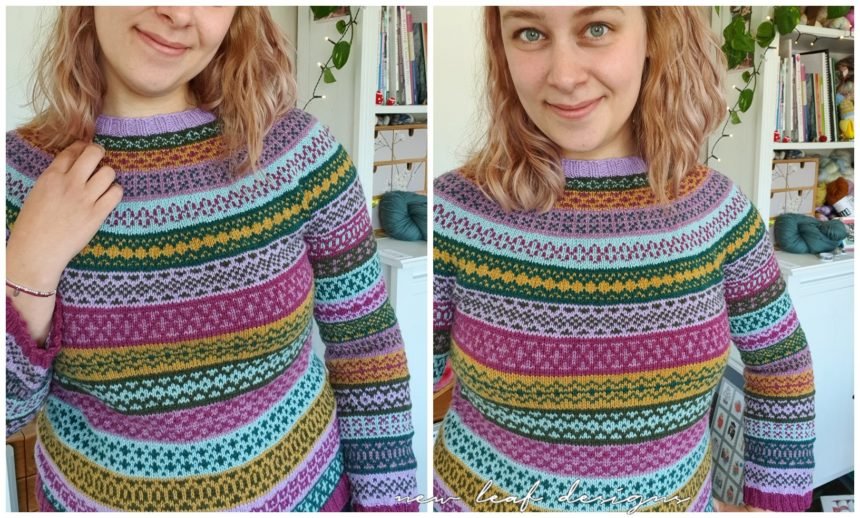
Nederlands Patroon
Materialen
Scheepjes Metropolis (75% Merino extra fijn, 25% nylon; 200 m/50 gr)
Voor maten 32;34;36;38(40;42;44;46)48;50;52;54 (56;58;60;62) heb je nodig: 8;8;9;9(10;10;11;11)11;12;13;13(13;14;14;14) bollen*
Hoeveelheid meters: 1485;1585;1690;1790(1895;1945;2045;2150) 2200;2300;2405;2455(2560;2660;2710;2760)
*De hoeveelheid bollen die je nodig hebt voor je trui hangt ervan af hoeveel kleuren je kiest. Als de trui in jouw maat 10 bollen nodig heeft, en je gebruikt 8 kleuren, heb je waarschijnlijk 2 bollen van elke kleur nodig. Je gebruikt namelijk gemiddeld 10/8= 1,25 bol per kleur.
Kleuren gebruikt voor sample:
016 Karachi (donker bosgroen)
026 Depok (donker olijfgroen)
050 Bogotá (bordeaux rood)
035 Seoul (mosterdgeel)
055 Lima (helder paars)
054 Johannesburg (zachtpaars)
019 Marseille (mintgroen)
80 cm lange rondbreinaalden in de volgende maten:
3 mm of andere maat waarmee je de correcte stekenverhouding krijgt
2,25 mm voor de boorden
Overige materialen:
Schaar
Stopnaald
4 steekmarkeerders; waarvan één goed te onderscheiden moet zijn van de andere drie als de BT (begin toer) marker
Stekenverhouding
Na opspannen:
27 stn x 32 toeren tricot kleurwerk met 3mm naalden meet 10 x 10 cm.
Opmerking: Gebruik zo nodig een andere naald om de juiste stekenverhouding te krijgen. Let op: brei je proeflapje in het rond.
Afkortingen
afh: averecht afhalen, van de linker naar rechter naald schuiven
AK: achterkant
av: averecht breien
BT: begin toer
CK: contrastkleur
GK: goede kant
HK: hoofdkleur
m.afh: marker afhalen
m: marker
M1: maak 1 steek (meerdering): pak horizontale draadje tussen huidige en volgende steek op en zet deze op linkernaald, brei vervolgens recht door linker ‘beentje’ om geen gat achter te laten.
pm: plaats marker
r: recht breien
2r.sbr: 2 steken recht samenbreien
s/stn: steek/steken
volg: volgende
(…) : herhaal de instructies tussen haakjes zo vaak als aangegeven.
[…] : stekenaantal
DS – Dubbele steek : hetzelfde als de “Duitse verkorte toeren” steek gebruikt voor o.a. sokken. Nadat je het werk hebt gekeerd, met garen naar voren, steek je de rechternaald van rechts naar links in de volgende steek op de linkernaald en haal je deze af. Trek garen strak en haal het OVER de naald naar achteren. NIET tussen de naalden door. Nu zie je op de rechternaald 2 kleine lusjes. Deze 2 lusjes tellen samen als één steek. Brei nu verder, let op dat je je garen naar voren haalt als de volgende steek een av steek is.
Maten
De afmetingen voor A-E staan vermeld in de maattabel hieronder.

Let op: deze trui is ontworpen om met 5-10 cm extra ruimte rondom de borst gedragen te worden. Alle trui afmetingen zijn gegeven in hun opgespannen staat.
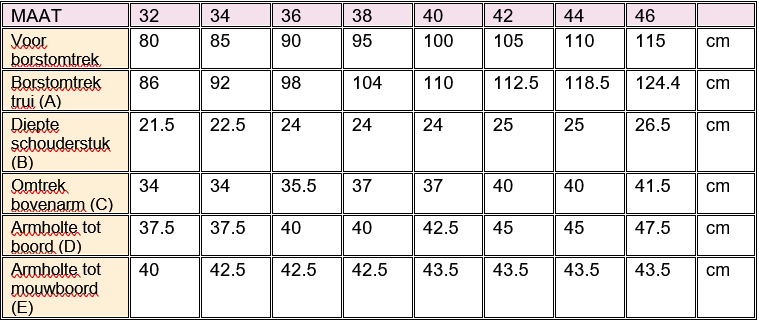
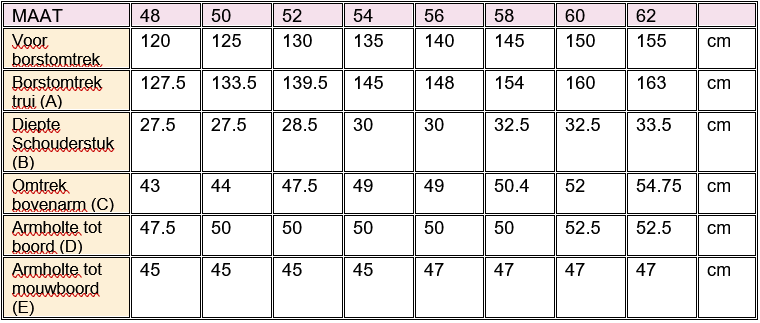
Patroon Opmerkingen
In dit patroon brei je een trui van boven naar beneden, in het rond. Je begint bij het nekboord en breit naar beneden. Aan de achterkant breien we verschillende verkorte toeren om de achterkant van de nek te verhogen. Gedurende het schouderstuk meerderen we een aantal keer. Daarna zet je twee sets steken op stekenhouders (bijv. restgaren) voor de mouwen. Je breit het lijf verder in toeren. De mouwen brei je vanaf de steken op de stekenhouders en brei je eveneens in toeren.
In het patroon zal ik naar de twee verschillende naaldmaten verwijzen als ‘kleinere naalden’ en ‘grotere naalden’. Het hangt van je stekenverhouding af of je de aanbevolen maat naalden gebruikt (zie Materialen)
Kleuren
Voor de kleurwerk gedeeltes gebruik je voor elk kleurwerk patroon twee kleuren garen. Deze twee kleuren moeten genoeg van elkaar verschillen zodat het patroon te zien is. Een manier om dit te bepalen is om een zwart-wit foto van je garens te nemen. Zijn je garens nog te onderscheiden, dan kun je ze samen gebruiken.
Voor mijn originele groen-paarse sample heb ik 3 donkere kleuren (Karachi, Depok, Bogotá) gebruikt en 4 lichtere kleuren (Marseille, Seoul, Johannesburg, Lima). De donkere kleuren kunnen gebruikt worden met de lichtere kleuren, maar gebruik de donkere kleuren onderling niet samen. Hetzelfde geldt voor de lichtere kleuren.
Voor mijn regenboogversie heb ik één doos gebruikt van Scheepjes Metropolis colour pack, waar 10gr bolletjes in zitten van elk van de 80 kleuren.
Kleurwerk breischema’s
De kleurwerk schema’s vind je onderaan deze blogpost, en zijn gerangschikt op aantal toeren. Denk eraan om tenminste 1 HK toer vóór en ná elk schema te breien. De schema’s lees je van beneden naar boven, en van rechts naar links. Elk schema laat 2 herhalingen zien, waarvan de hoofdherhaling rood is omlijnd. Elk hokje staat voor één steek: de witte steken zijn HK steken, de zwarte (hoofdherhaling) en grijze (buiten hoofdherhaling) zijn CK steken.
Elk kleurwerk schema herhaalt zich over 4 steken.
Patroon
Instructies en stekenaantallen voor verschillende maten worden als volgt weergegeven: 32;34;36;38(40;42;44;46)48;50;52;54(56;58;60;62)
Soms worden instructies anders gegeven, bijvoorbeeld:
Voor maten 34;40;44;52: “…”
Maat 42: “…”
Zoek in dit geval jouw maat eruit en volg de bijbehorende instructies.
Opzetten
Met kleinere naalden en jouw kleur naar keuze voor de nekboord, zet 96;100;108;112 (120;124;128;136) 140;144;148;152 (156;160;164;168) stn op, pm na elke 24;25;27;28 (30;31;32;34) 35;36;37;38 (39;40;41;42) stn.
Breng je naaldpunten naar elkaar om verder te gaan in het rond, let erop dat je je steken niet verdraait. Plaats de BT marker bij de aanhechting. De BT marker bevindt zich op de trui aan de achterkant van de rechterschouder.
In totaal heb je nu 4 markers. Deze markers verdelen je steken in 4 gelijke delen en gebruik je bij de verkorte toeren. Als ze niet genoemd worden, moet je ze gewoon van de een naar de andere naald schuiven.
Brei ongeveer 2,5 cm 2×2 boordsteek.
Wissel naar grotere naalden voor de volgende toer en hecht eerste HK aan. Je kunt de kleur van het boord afknippen.
Meerdertoer 1
LET OP: soms moet je een meerdering maken bij een marker. Doe dit dan vóór de marker er niet erna.
Voor maten 32;38;44;50;58: (4r, m1) tot eind. [120;140;160;180;200 stn]
Maat 34: 2R, (m1, 3r) 6x, (m1, 4r) 15x, (m1, 3r) 6x, m1, 2r. [128 stn]
Maat 36: 2r, (m1, 3r) 2x, (m1, 4r) 23x, (m1, 3r) 2x, m1, 2r. [136 stn]
Maat 40: 2r, (m1, 3r) 4x, (m1, 4r) 23x, (m1, 3r) 4x, m1, 2r. [152 stn]
Maat 42: 2r, (m1, 3r) 2x, (m1, 4r) 27x, (m1, 3r) 2x, m1, 2r. [156 stn]
Maat 46: 2r, (m1, 3r) 4x, (m1, 4r) 27x, (m1, 3r) 4x, m1, 2r. [172 stn]
Maat 48: 2r, (m1, 3r) 2x, (m1, 4r) 31x, (m1, 3r) 2x, m1, 2r. [176 stn]
Maat 52: 2r, (m1, 3r) 6x, (m1, 4r) 27x, (m1, 3r) 6x, m1, 2r. [188 stn]
Maat 54: 2r, (m1, 3r) 4x, (m1, 4r) 31x, (m1, 3r) 4x, m1, 2r. [192 stn]
Maat 56: 2r, (m1, 3r) 2x, (m1, 4r) 35x, (m1, 3r) 2x, m1, 2r. [196 stn]
Maat 60: 2r, (m1, 3r) 6x, (m1, 4r) 31x, (m1, 3r) 6x, m1, 2r. [208 stn]
Maat 62: 2r, (m1, 3r) 4x, (m1, 4r) 35x, (m1, 3r) 4x, m1, 2r. [212 stn]
Steken gemeerderd: 24;28;28;28 (32;32;32;36) 36;36;40;40 (40;40;44;44).
Verkorte toer 1
Brei alle stn tot volg m r, keer, DS, brei alle stn tot BT av, m.afh, brei alle stn tot volg m av, m.afh, brei alle stn tot volg m av, keer, DS, brei alle stn tot BT r.
Kleurwerk gedeelte
Voor je eerste kleurwerk patroon kies je een patroon van 5 toeren. Vind de kleurwerk patronen op p.12. De DS behandel je als één steek. Na het kleurwerk knip je de CK maar houd je de HK.
Meerdertoer 2
Direct na je eerste kleurwerk patroon breien we de 2e meerdertoer. Gebruik de HK van vorig kleurwerk patroon voor de meerdertoer:
Voor maten 42;50;54: (3r, m1) tot eind. [208;240;256 stn]
Maat 32: k1, (m1, 3r) 12x, (m1, 2r) 23x, (m1, 3r) 12x, m1, k1. [168 stn]
Maat 34: k1, (m1, 3r) 16x, (m1, 2r) 15x, (m1, 3r) 16x, m1, k1. [176 stn]
Maat 36: k1, (m1, 3r) 20x, (m1, 2r) 7x, (m1, 3r) 20x, m1, k1. [184 stn]
Maat 38: k1, (m1, 3r) 18x, (m1, 2r) 15x, (m1, 3r) 18x, m1, k1. [192 stn]
Maat 40: 2r, (m1, 3r) 20x, (m1, 4r) 7x, (m1, 3r) 20x, m1, 2r. [200 stn]
Maat 44: k1, (m1, 3r) 24x, (m1, 2r) 7x, (m1, 3r) 24x, m1, k1. [216 stn]
Maat 46: 2r, (m1, 3r) 18x, (m1, 4r) 15x, (m1, 3r) 18x, m1, 2r. [224 stn]
Maat 48: 2r, (m1, 3r) 24x, (m1, 4r) 7x, (m1, 3r) 24x, m1, 2r. [232 stn]
Maat 52: 2r, (m1, 3r) 26x, (m1, 4r) 7x, (m1, 3r) 26x, m1, 2r. [248 stn]
Maat 56: k1, (m1, 3r) 30x, (m1, 2r) 7x, (m1, 3r) 30x, m1, k1. [264 stn]
Maat 58: k1, (m1, 3r) 28x, (m1, 2r) 15x, (m1, 3r) 28x, m1, k1. [272 stn]
Maat 60: k1, (m1, 3r) 32x, (m1, 2r) 7x, (m1, 3r) 32x, m1, k1. [280 stn]
Maat 62: k1, (m1, 3r) 30x, (m1, 2r) 15x, (m1, 3r) 30x, m1, k1. [288 stn]
Wissel naar andere HK. Brei 1 toer recht.
LET OP: wanneer je wisselt naar een nieuwe HK of CK kun je de vorige afknippen. Je hoeft de garens niet achter je werk mee te nemen.
Steken gemeerderd: 48;48;48;52 (48;52;56;52) 56;60;60;64 (68;72;72;76).
Verkorte Toer 2
Brei alle stn tot volg m r, keer, DS, brei alle stn tot BT av, m.afh, brei alle stn tot volg m av, m.afh, brei alle stn tot volg m av, keer, DS, brei alle stn tot BT r.
Kleurwerk gedeelte
Start je volgende kleurwerk patroon, behandel de DS als één steek. Vanaf hier tot aan de volgende instructies heb je 12;13;15;16(17;18;19;20) 21;22;23;24 (25;26;27;27) toeren om de door jou gekozen kleurwerk patronen te breien.
Gebruik de kleurwerk schema’s onderaan deze blogpost en plan welke je gaat gebruiken. Vóór en ná elk kleurwerk patroon moet je tenminste 1 HK toer breien om het af te maken. Deze toeren tellen mee in het aantal toeren dat hierboven genoemd is.
LET OP: als de door jou gekozen kleurwerk patronen niet tot het benodigde aantal toeren komen, dan kun je het verschil aan toeren bij het volgende gedeelte verrekenen. Stel nu dat je 24 toeren moet breien, maar je komt maar aan 22, dan tel je er 2 op bij het volgende gedeelte. Ik zou adviseren niet meer dan 3 toeren erbij op te tellen of vanaf te trekken zodat de pasvorm van je trui hetzelfde blijft.
Wissel naar volgende HK, brei 1 toer recht. Even voor de duidelijkheid: deze toer is NIET meegeteld in het aantal toeren hierboven.
Meerdertoer 3
Alle maten: (2r, m1) tot eind.
Stekenaantallen voor alle maten na meerdertoer 3: 252;264;276;288 (300;312;324;336) 348;360;372;384 (396;408;420;432).
Steken gemeerderd: 84;88;92;96 (100;104;108;112) 116;120;124;128 (132;136;140;144).
Kleurwerk gedeelte
Brei je volgende set kleurwerk patronen, je hebt 12;13;15;16(17;18;19;20) 21;22;23;24 (25;26;27;27) toeren tot de volgende instructies.
Wissel naar volgende HK, brei 1 toer recht.
Meerdertoer 4
Alle maten: (3r, m1) tot eind.
Stekenaantallen voor alle maten na meerdertoer 4: 336;352;368;384 (400;416;432;448) 464;480;496;512 (528;544;560;576).
Steken gemeerderd: 84;88;92;96 (100;104;108;112) 116;120;124;128 (132;136;140;144).
Kleurwerk gedeelte
Voor je volgende set kleurwerk patronen heb je te maken met een verkorte toer in de laatste streep kleurwerk. Voor het hele gedeelte heb je: 31;33;36;34(32;34;32;34) 32;34;36;38 (36;42;40;41) toeren.
Nadat je de EERSTE HK TOER van de LAATSTE streep kleurwerk hebt gebreid, volg je de instructies bij “VERKORTE TOER 3”.
Verkorte Toer 3
Brei alle stn tot volg m r, keer, DS, brei alle stn tot BT av, brei alle stn tot volg m av, m.afh, brei alle stn tot volg m av, keer, DS, brei alle stn tot BT r.
Start nu het kleurwerk schema van je laatste streep en eindig met een HK toer zoals hierboven vermeld.
Mouwen splitsen
LET OP: voor het opzetten van steken in de armholtes gebruik je de lussen opzet methode. Verwijder alle markers behalve de BT marker
Wissel naar volgende HK,
Brei 6,8,9,10(12,11,13,14)14,15,16,16(18,19,19,18) stn r,
plaats 72,72,74,76(76,82,82,84)88,90,92,96(96,98,102,108) stn op houder,
zet 20,20,22,24(24,26,26,28) 28,30,32,36(32,34,38,40) stn op,
brei 96,104,110,116(124,126,134,140)144,150,156,160(168,174,178,180) stn r,
plaats 72,72,74,76(76,82,82,84)88,90,92,96(96,98,102,108) stn op houder,
zet 20,20,22,24(24,26,26,28) 28,30,32,36(32,34,38,40) stn op,
brei 90,96,101,106(112,115,121,126)130,135,140,144(150,155,159,162) stn tot BT.
Stn over voor lijf: 232,248,264,280(296,304,320,336)344,360,376,392(400,416,432,440).
Brei 1 toer recht met HK voordat je het volgende kleurwerk patroon begint.
Lijf
Brei vanaf hier door tot aan de gewenste lengte minus 2,5 cm (voor boord).
Let erop dat je minstens 1 HK toer breit vóór en ná elk kleurwerk patroon. Afhankelijk van je voorkeur kun je ook 2 HK toeren breien. Voor de sample trui heb ik soms 1 HK toer gebreid, soms 2 toeren.
De standaard lengte voor armholte tot boord vind je in de maattabel, maar deze verschilt erg per persoon. Je kunt dit gemakkelijk verlengen of juist verkorten.
Boord Onderrand
Kies welke kleur je gebruikt voor het boord en brei daarmee 1 toer recht.
Wissel naar kleinere naalden en brei ongeveer 2,5 cm 2×2 boordsteek. Kant losjes af in patroon – daarmee bedoel ik brei de rechte steken recht, en de averechte steken averecht.
Mouwen
Maak er twee hetzelfde
Met grotere naalden en HK naar keuze, met GK naar je toe, pak je 20,20,22,24(24,26,26,28)28,30,36,36(36,38,38,40) stn op bij de armholte. Plaats een marker in het midden van deze stn. Brei dan de 72,72,74,76(76,82,82,84)88,90,92,96(96,98,102,108) stn r van de houder. Brei nogmaals de eerste helft van je armholte stn zodat je weer bij de marker bent.
Totaal aantal stn voor mouw: 92,92,96,100(100,108,108,112)116,120,128,132(132,136,140,148).
Ik raad aan om nog 1 HK toer te breien voordat je het eerste kleurwerk patroon begint. Kies en mix de kleurwerk patronen voor de mouw zoals je ook voor het lijf hebt gedaan.
OPMERKING VOOR MINDEREN
Ik raad aan om je trui vaak te passen zodat je kunt zien of je wellicht stn wilt minderen in de mouw. In mijn ervaring wisselt arm omtrek sterk van persoon tot persoon, zelfs met dezelfde maat borstomtrek. Voor mijn eigen trui plaatste ik 5 mindertoeren, 1 vóór en 4 ná de elleboog. In de toer net voor het boord minderde ik nog eens 12 stn.
Mindertoer:
In de laatste HK toer van een streep: brei 2r.sbr 4x, verdeeld over de toer. Bijvoorbeeld als je 100 stn hebt: (23r, 2r.sbr) tot eind.
Het is beter om slechts 4stn per keer te minderen. Als je meer wilt minderen, kun je deze toer nog eens doen bij het volgende kleurwerk patroon.
TIP: plaats een marker in je mindertoer zodat je dit voor je 2e mouw op dezelfde plek kan doen.
Brei je mouwen in kleurwerk patronen tot 2,5 cm vóór je gewenste lengte. De standaard lengte vind je in de maattabel.
Mouwboord
Brei met jouw kleur naar keuze 1 toer recht. Wissel naar kleinere naalden en brei ongeveer 2,5 cm 2×2 boordsteek. Kant losjes af in patroon – daarmee bedoel ik brei de rechte steken recht, en de averechte steken averecht.
Afwerking
Werk alle draadjes weg en span op naar afmetingen. TIP: knip de eindjes pas ná het wassen, anders schieten deze misschien los.
Shop more patterns here Shop andere patronen hier
Colourwork Charts | Kleurwerk schema’s
Please don’t forget to add at least 1 MC round before and after each chart.
Vergeet niet ten minste 1 HK toer vóór en na elk schema te breien.
3 rounds | 3 toeren

5 rounds | 5 toeren

6 rounds | 6 toeren

7 rounds | 7 toeren

9 rounds | 9 toeren
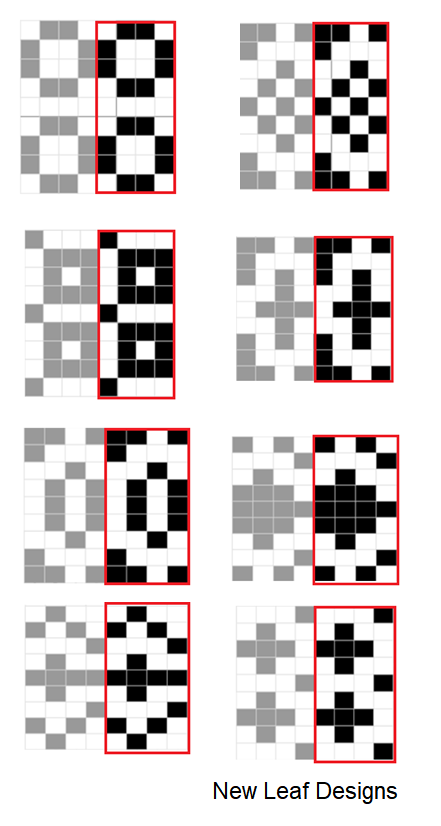
Copyright notice
This knitting pattern is a design of my own. While you can make as many sweaters as you like with this pattern, I continue to own the copyright. Copyright protected by Scheepjes. I ask you to not reproduce this pattern in any way. Please do not email it to others, hand out copies or use it in workshops. If you want to make kits, please contact me first: hello@newleafdesigns.nl. You may sell the sweaters you make with this pattern.
Share your pictures in my Facebook group New Leaf Designs Knitting & Crochet Crew.
Dit breipatroon is mijn eigen ontwerp. Je mag zoveel truien ermee breien als je wilt, maar het copyright blijft mijn eigendom. Daarom vraag ik je ook om dit patroon NIET door te sturen aan anderen, kopietjes uit te delen, of te gebruiken in workshops. Als je het patroon toe wilt voegen aan brei kits in je winkel contacteer mij dan eerst: hello@newleafdesigns.nl. Gemaakte truien met dit patroon mogen wel verkocht worden.
Deel je foto’s in mijn Facebook groep New Leaf Designs Knitting & Crochet Crew.


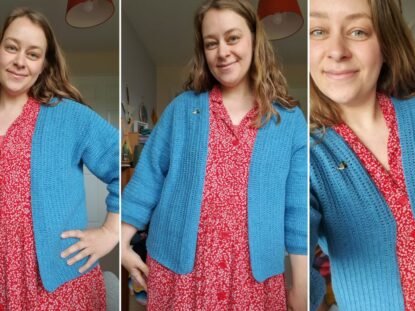
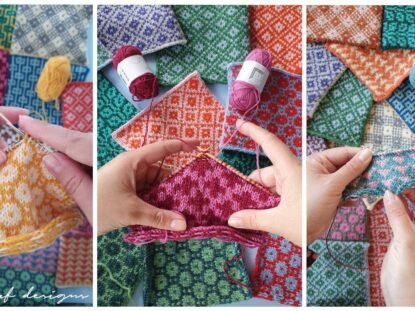


6 Comments
[…] Around the World sweater is a free pattern right here on my website. I made one sample with regular 50 gram balls of Scheepjes Metropolis, and another sample with the […]
[…] soft and sturdy at the same time. I use it for WAY more than just socks, I’ve also knit sweaters and hats with this […]
[…] Around the World Sweater Pattern […]
Goedemiddag,
Wat een prachtige ontwerpen van de Sassenach-kussens!!
Ik ben voorlopig alleen van plan om het “Claire”-kussen te maken. Heb ik dan genoeg aan 2 bollen van de basiskleur en van alle andere kleuren 1 bol??
(Dat is zo ongeveer de helft van het totale pakket voor beide kussens).
Ik kan niet afwachten tot de KAL gaat starten!!
met vriendelijke groet,
[…] are so quick and only take small amounts of yarn. I had some Scheepjes Metropolis leftovers from my Around the World sweaters, and that was more than enough to knit a couple of hats! I’m knitting my third hat, and have […]
[…] as €5 a month, and you can unsubscribe anytime. Not ready for a commitment? Have a look at the free knitting pattern for the sweater and see if you can figure it out by yourself. If you need some extra guidance, you […]